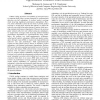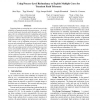105 search results - page 1 / 21 » Opportunistic Transient-Fault Detection |
ISCA
2005
IEEE
13 years 11 months ago
2005
IEEE
CMOS scaling increases susceptibility of microprocessors to transient faults. Most current proposals for transient-fault detection use full redundancy to achieve perfect coverage ...
DSN
2007
IEEE
14 years 14 days ago
2007
IEEE
Transient faults are emerging as a critical concern in the reliability of general-purpose microprocessors. As architectural trends point towards multi-threaded multi-core designs,...
DEPCOS
2007
IEEE
13 years 10 months ago
2007
IEEE
State automata are implemented in numerous ways and technologies
DSN
2007
IEEE
14 years 14 days ago
2007
IEEE
A new approach is proposed that exploits repetition inherent in programs to provide low-overhead transient fault protection in a processor. Programs repeatedly execute the same in...
ISCA
2000
IEEE
13 years 10 months ago
2000
IEEE
Smaller feature sizes, reduced voltage levels, higher transistor counts, and reduced noise margins make future generations of microprocessors increasingly prone to transient hardw...


